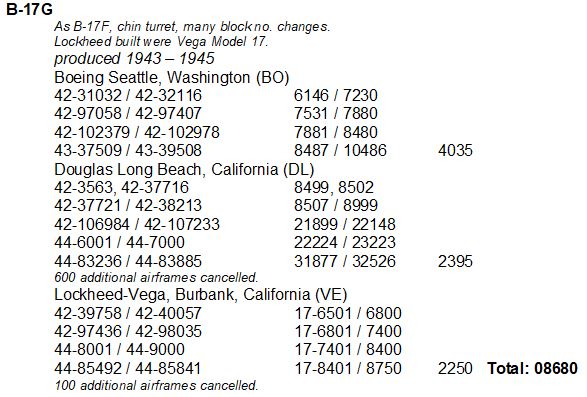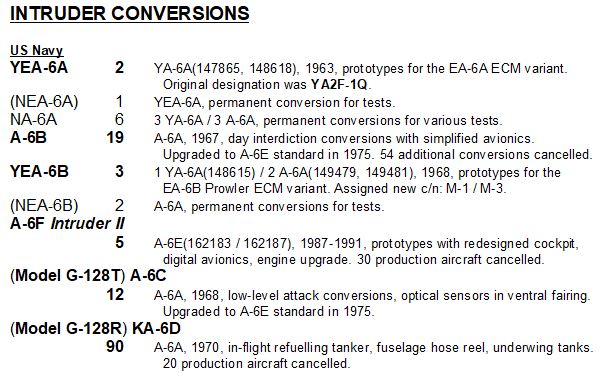decisive and enduring World War II, Post World War II (Cold War / Vietnam Era) & The
Modern Era (Gulf War and beyond) and Present Day military aircraft of the United States
Air Force, Army and Navy.
US Warplanes is designed as a quick reference site for aviation researchers and enthusiasts
who are looking for a concise listing of aircraft type variants, conversions and serial
numbers. The site does not go into a detailed description of aircraft histories or service
and does not discuss any one individual aircraft service history.
The website uses a variety of sources, these being primary references like official documents
and records from established air force museums, published reference books on aviation
subjects, magazine publications, other aviation websites and email correspondence
with aviation historians and enthusiasts around the world.

(1) The pdf aircraft file presentations are formatted for the European A4 (210mm x 297mm) paper
size. U.S. and Canadian visitors may have difficulty printing these formats when using
their standard Letter (10 x 8.5 inches) paper size.
(2) The designation / serial number presentations are based on what the aircraft was when it rolled out
the factory door. Many types had modifications, inter-service changes etc. post-delivery and these are
noted where possible.
(3) Initial US serial numbers are noted plus initial customer serial numbers for foreign military sales etc.
Second-hand and subsequent sales are not recorded as this moves outside the scope of the website.
(4) Static test airframes that were issued with either a serial or construction number are listed and
counted in the final totals.
(5) Within each file, serial numbers are noted in the first column followed by construction numbers
then sub-totals and totals.
(6) The term "mixed XXX to XXX" means a group of serial or factory numbers do not follow a normal
numerical sequential order or it has been too lengthy to type out the entire sequence - remember this
site is trying to remain relatively concise.
(7) The term "1+" in the conversions section refers to where the number of actual conversions isn't known
but it is certainly more than one. Sometimes these conversions can run into the many hundreds.

The information that follows is a guide to how these sections are constructed and presented.
SERVICE
This section introduces the aircraft type with various information like the model, designation, names
and the main time frames the type was in production and service.
Manufacturer: This is the location of the manufacturer's MAIN CORPORATE HEADQUARTERS at
the time the first prototype flew, not the manufacturing plant(s) where production was undertaken.
Subsequent locations are also noted if the main headquarters was shifted during the production run.
Name changes of manufacturers are also noted if these occurred also during an aircraft's production
run, e.g. Consolidated to Consolidated-Vultee to Convair.
Model: This is simply the manufacturer's own company designation for an aircraft type. Greater detail of
model designations can be found in the variant section.
Designation: This is a rundown of all designations officially applied to an aircraft type across all of the
services - Air Force, Army and Navy. Designations in use by close-ally countries are also included.
Name: This lists the OFFICIAL name(s) of a type as bestowed by the Air Force, Army or Navy, it does
also list unofficial names, e.g. Blackbird (SR-71), Aardvark (F-111), but does not list nick-names or slang
expressions. Names in use by close-ally countries are also included.
First official flight: Basically the first flight of the prototype aircraft. If the prototype was a conversion
from an earlier model, e.g. XP-40, XC-119, the official flight of the first production aircraft is also listed.
Factory production period: This spans the time in years from the construction of the first prototype to the
last year of production of the last variant.
Primary service period: This is an aircraft's main, front-line service period, not the entire service period
it was on active duty. Most aircraft have a primary service period before being outdated by a newer
model and becoming obsolete or assigned to second line duties. Aircraft assigned drone duties, (e.g.
QF-102, QF-4), are not included as these aircraft have been written-off so to speak and are not
technically in service.
Last official flight: An aircraft types last assigned mission before being finally retired completely from
active duty, e.g. although the B-29 was no longer a front-line aircraft by 1953, its last official flight was
not until 1960.
VARIANTS
This part presents a list of an aircraft's NEW BUILT variants as they were designated when they came
off the production line. Some designations were changed after delivery due to service reassignment or
Lend-Lease etc. and these are listed where possible. The example below shows the layout which
consists of year of first flight, model, designation, sub-total and totals.

PRODUCTION
The Production section is a rundown of the variants presented above but with a brief description
attached of important information. The variant's production period and plant location(s) with their
two letter codes are also listed along with the serial numbers and construction numbers of that
particular plant location. The example below details a typical layout of designation, description,
period built, factory, serial numbers, construction numbers, sub-totals and total.

CONVERSIONS & TRANSFERS
These are the NEW BUILT variants converted to a secondary role such as tankers, cargo conversions,
VIP transports etc. It's also for aircraft that have had a change of designation by transfer to another
service branch such as the Navy, Army or Coast Guard.
This section also lists transfers (ones not listed under Production) to other countries where often
a new designation was applied, especially transfers to wartime Commonwealth nations.
Also listed are 'Civil Impressions' which are civilian operated / owned aircraft
which were drafted into wartime military service.
The example below shows a typical layout of designation, quantity and description.

Secondary conversions are presented in brackets underneath the original conversion.
Proposed designs or cancelled conversions are presented as italics.
Aircraft in bold type have three separate categories:
The first are prototypes that contribute a significant development to that aircraft type.
The second are production conversions that also contribute a large development to that aircraft
type, e.g. KB-29P, C-123K, C-141B etc.
The third are for conversions with a newly assigned designation e.g. C-108 (from B-17), C-109
(from B-24) or F-61 (from P-61) etc.

Listing block numbers is a major task on any scale and is outside the scope of this website which is only
aimed at giving an overall view of the variants, factory locations, production periods and numbers built
of any particular aircraft.
There were many hundreds of aircraft types developed and tested by the US Armed Forces over the years
since aircraft became a formidable form of combat. Some never got off the drawing board and others only
made it as far as the prototype stage - for these reasons this part of aviation history is another story and
non-production aircraft are not included on this website.